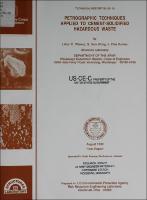Please use this identifier to cite or link to this item:
https://hdl.handle.net/11681/11134Full metadata record
| DC Field | Value | Language |
|---|---|---|
| dc.contributor | Risk Reduction Engineering Laboratory (U.S.) | - |
| dc.contributor.author | Wakeley, Lillian D. | - |
| dc.contributor.author | Wong, G. Sam | - |
| dc.contributor.author | Burkes, J. P. | - |
| dc.date.accessioned | 2016-06-20T14:15:35Z | - |
| dc.date.available | 2016-06-20T14:15:35Z | - |
| dc.date.issued | 1992-08 | - |
| dc.identifier.uri | http://hdl.handle.net/11681/11134 | - |
| dc.description | Technical Report | - |
| dc.description | Abstract: Twelve techniques used routinely in laboratory investigations of portland cement concretes and grouts were applied to three cement-solidified wasteforms from an EPA Superfund site. The objective was to determine if the presence of the wastes made these solidified materials fundamentally different from conventional grouts. Other objectives were to determine if techniques used routinely in concrete technology are applicable to such wasteforms and to identify what unique and useful information they can provide for determining the likelihood for durability of the wasteform. Petrographic examination of thin sections of wasteforms prepared with fluorescent epoxy resin proved to be useful for determining effectiveness of waste dispersion in the cementing medium and distribution of cracks. Scanning electron microscopy coupled with high-resolution X-ray mapping revealed details of microstructure and distribution of important ions. X-ray powder diffraction confirmed the formation of the usual hydrated phases of portland cement and pozzolans. Pulse velocity measurements indicated absence of serious degradation over an 18-month period of time. The petrographic and nondestructive analytical techniques common in concrete technology and applied to wasteform grouts in this study can be applied to these cement-solidified wastes. These techniques indicate if the materials have stable phase composition, if their microstructures demonstrate uniform waste dispersal, and if mass or structural integrity is sufficient so that large blocks of these materials are unlikely to disintegrate in place. | - |
| dc.publisher | Structures Laboratory (U.S.) | - |
| dc.publisher | Engineer Research and Development Center (U.S.) | - |
| dc.relation | http://acwc.sdp.sirsi.net/client/en_US/search/asset/1035403 | - |
| dc.relation.ispartofseries | Technical report (U.S. Army Engineer Waterways Experiment Station) ; SL-92-19. | - |
| dc.rights | Approved for public release; distribution is unlimited. | - |
| dc.source | This Digital Resource was created from scans of the Print Resource | - |
| dc.subject | Cement microscopy | - |
| dc.subject | Concrete petrography | - |
| dc.subject | Grout | - |
| dc.subject | Image analysis | - |
| dc.subject | Pulse velocity | - |
| dc.subject | Scanning electron microscopy | - |
| dc.subject | Solidification | - |
| dc.subject | Solidified waste | - |
| dc.subject | Stabilization | - |
| dc.subject | Wasteform | - |
| dc.subject | Hazardous wastes | - |
| dc.title | Petrographic techniques applied to cement-solidified hazardous waste | - |
| dc.type | Report | en_US |
| Appears in Collections: | Technical Report | |
Files in This Item:
| File | Description | Size | Format | |
|---|---|---|---|---|
| TR-SL-92-19.pdf | 3.98 MB | Adobe PDF |  View/Open |